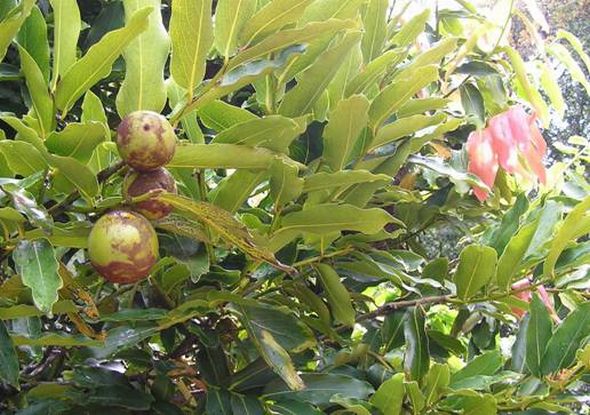

|

Clayton Shillingford
Plant Family: Belongs to the Ebenaceae, or Ebony/Persimon family, which includes the black-wooded Ebony (Diospyros ebenum) of S. Asia, and the Persimon (D. kaki) of China; the Forestry Divisionís 1988 Guide identifies this tree only as Diospyros sp., while the 1924 Official Guide identifies a tree in this general location as the Mabolo fruit of India (D. discolor).
Description: Located on south side of road approaching Elmshall Gate; slow growing, small tree about 5-6 m (16-20 ft); leaves alternate, opposite and lanceolate, 10-18 cm long (4-7 in) and 5-8 cm wide (2-3 in), shiny on upper surface, young leaves a beautiful purplish pink; fruit globular, about size of large lime or small apple, 5-8 cm across (2-3 in), light green, with dark brown powdery deposit on surface, yellow when ripe with characteristic persistent calyx of Persimon; edible, with sweet, yellow flesh of mango-like texture, but astringent if not fully ripe, similar to some varieties of Persimon; reportedly, contact with leaves, bark, fruit, root, or wood dust of some members of this genus can cause dermatitis and blisters in sensitive individuals; some species are known to contain the irritant plumbagin.
Origin and Distribution: Various Diospyros sp found from the temperate regions of N. America and Asia to the humid tropics of Africa, SE Asia and the Americas.
Uses: Diospyros sp present a varied picture; genus generally has beautiful wood, with some species providing valuable timber such as Ebony (D. ebenum) and the rear Calamander (D. quaesita); others produce popular edible fruits such as Persimon (D. kaki) and Mabolo (D. discolor); in Mexico, the fruit of Guayabota (D. ebenaster), a beautiful flowering tree of the forest, when ripe is well liked, while in Dominica, the Caribs used crushed fruit and chipped bark of same tree, here called Bois Bambarra, which they immersed in pools to stun or stupify fish which then floated to surface and were caught; False Ebony, especially when flush with young leaves, and Persimon, particularly when in fruit, make beautiful specimen ornamentals.
References:
Dominica Forestry & Wildlife Division. Dominica's Botanic Gardens: A Guide to Selected Trees and Shrubs, Ministry of Agriculture, Dominica 1988
Anon. Official Guide to the Botanic Gardens, Dominica. Kew Gardens, London, 1924?
H.F. Macmillan. Tropical Planting and Gardening. Macmillan, London 1956
Dan H. Nicolson. Flora of Dominica, Part 2: Dicotyledoneae. Smithsonian Institution, Washington, D.C. 1991
Richard J. Schmit, Botanical Dermatology Database. (bodd.cf.ac.uk) Electronic version of John Mitchell & Arthur Rook, Botanical Dermatology. Greengrass, Vancouver, 1979
Robert A. DeFilipps. Useful Plants of the Commonwealth of Dominica, West Indies. Smithsonian Institution, Washington, D.C. 1998
|



